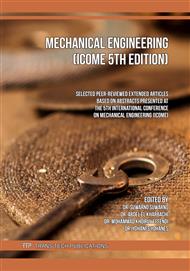[1]
C.S.A. M.R.S. a. L.G.R. Follador, Comparison of In-Flight Measured and Computed Aeroelastic Damping: Modal Identification Procedures and Modelling Approaches,, Journal Aerospace Technology Management, pp.163-177, (2016).
DOI: 10.5028/jatm.v8i2.558
Google Scholar
[2]
A.S.C. a. A.C. Marta, Aeroelastic Analysis of Aircraft Wings,, Congresso de Metods Numerios em Engenharia 2015, (2015).
Google Scholar
[3]
J. R. Wright and J. E. Cooper, Introduction to Aircraft Aeroelasticity and Loads, Liverpool: John Wiley & Sons, Ltd, (2007).
Google Scholar
[4]
J. Njuguna, Flutter Prediction, Suppression and Control in Aircraft Composite Wings as a Design Prerequisite,, Structural Control and Health Monitoring, vol. 14, no. 5, pp.715-758, (2007).
DOI: 10.1002/stc.170
Google Scholar
[5]
W. Chajec, Flutter Calculation Based on GVT-Results and Theoretical Mass Model,, Journal Aviation, vol. 13, no. 4, pp.122-129, (2010).
DOI: 10.3846/1648-7788.2009.13.122-129
Google Scholar
[6]
A. C. Pankaj, G. Shanthini, M. V. Shivaprasad and M. Manjuprasad, Aircraft Flutter Prediction Using Experimental Modal Parameters,, Aircraft Engineering and Aerospace Technologgy: An International Journal, vol. 85, no. 2, pp.87-96, (2013).
DOI: 10.1108/00022661311302698
Google Scholar
[7]
M. M. Khatibi, M. R. Ashory, A. Malekjafarian and R. Brincker, Mass-stiffness Change Method for Scaling of Operational Mode Shapes,, Mechanical Systems and Signal Processing, vol. 26, no. 1, pp.34-59, (2012).
DOI: 10.1016/j.ymssp.2011.07.012
Google Scholar
[8]
N. S. and A. A, Analysis & Design of Tubular Testrig,, International Research Journal of Engineering and Technology (IRJET), vol. 4, no. 5, pp.3052-3056, (2017).
Google Scholar
[9]
G. Piana, Vibrations and Stability of Axially and Transversely Loaded Structures,, Politecnico di Torino, Torino, (2012).
Google Scholar
[10]
T. Clara, J. F. d. Campos and J. Baltazar, Added Mass Effects on The Natural Frequencies of Marine Current Turbine Blades,, in Proceedings of the 6th International Conference on Mechanical in Design, Lisbon, (2015).
Google Scholar
[11]
A. A. Khan, A. M. Khan and N. S. Khan, Mass Distribution Effect on Flutter Characteristics,, in Proceeding of (IMETI 2012) The 5th International Multi Conference on Engineering and Technological Innovation, Islamabad, (2012).
Google Scholar
[12]
S. G. Kelly, Mechanical Vibrations: Theory and Application, Boston: Cengage Learning, (2012).
Google Scholar
[13]
S. Chakraverty, Vibrations of Plate, New York: CRC Press, (2009).
Google Scholar
[14]
S. S. Rao, Vibration of Continuous Systems, New Jersey: John Wiley & Sons, Inc, (2007).
Google Scholar
[15]
Y. I. Bobrovnitskii, Some Energy Relation for Mechanical Systems,, IUTAM Symposium on Statical Energy Analysis Solid Mechanics and Its Application, vol. 67, pp.37-46, (1999).
DOI: 10.1007/978-94-015-9173-7_4
Google Scholar
[16]
M. Software, MSC Nastran 2012 Dynmic Analysis User's Guide, USA: MSC. Software Corporation, (2011).
Google Scholar
[17]
G. Voss, D. Schaefer and V. Cyrille, Investigation on Flutter Stability of the DLR-F19/SACCON Configuration,, Aerospace Science and Technology, pp.1-11, (2019).
DOI: 10.1016/j.ast.2019.105320
Google Scholar
[18]
S. W. Bostic and R. E. Fulton, Implementation of the Lanczos Method for Structural Vibration Analysis on a Parallel Computer,, Computer and Structures, vol. 25, no. 3, pp.395-403, (1987).
DOI: 10.1016/0045-7949(87)90131-3
Google Scholar
[19]
V. I. Weingarten, R. K. Ramanathan and C. N. Chen, Lanczos Eigenvalue Algorithm for Large Structure on a Minicomputer,, Computer and Structures, vol. 16, no. 1-4, pp.253-257, (1983).
DOI: 10.1016/0045-7949(83)90165-7
Google Scholar



